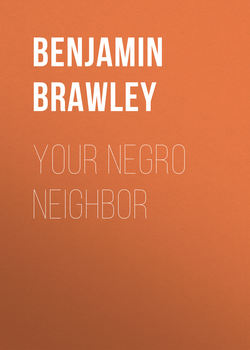Your Negro Neighbor

Реклама. ООО «ЛитРес», ИНН: 7719571260.
Оглавление
Benjamin Brawley. Your Negro Neighbor
I. YOUR NEGRO NEIGHBOR
II. THE NEGRO IN AMERICA: HISTORICAL REVIEW1
III. THE NEGRO AS AN INDUSTRIAL FACTOR
IV. LYNCHING
V. ASPECTS OF NEGRO EDUCATION
VI. A GREAT MISSIONARY: JOANNA P. MOORE
VII. SOME CRITICS AND THEIR FALLACIES
VIII. THE PROMISE OF THE NEGRO
IX. A PLEA FOR A MORALIST
Отрывок из книги
It was in August, 1619, that a Dutch vessel brought to Jamestown, Va., twenty Negroes, who were sold into servitude. While this event definitely signalized the coming of the Negro for permanent residence within the limits of what is now the United States, it by no means marked his first coming to this country. The records of the Negro extend as far back as the voyages of Columbus. Within a few years after the visits of the great explorer there were several Negroes in the West Indies, and in 1513 thirty assisted Balboa in the building of the first ships made on the Pacific Coast. One of the four survivors of the ill-starred expedition of De Narvaez in 1527 was the Negro Estevanico, to whom belongs the credit of the discovery of the Zuñi Indians and of New Mexico. Nothing from these early years, however, exercised any abiding influence on the history of the Negro in the United States.
The status of the Negro after 1619 was for several decades complicated by the system of indentured labor known as servitude. This applied especially to white servants brought from England; but the first Negroes brought to the country technically fell into the system. According to the New International Encyclopedia, "Servitude became slavery when to such incidents as alienation, disfranchisement, whipping, and limited marriage, were added those of perpetual service and a denial of civil, juridical, marital and property rights as well as the denial of the possession of children." While legislation was enacted earlier in Massachusetts, it was Virginia that in 1661 really led the way for the South in the definite recognition of slavery as a system by saying that Negroes were "incapable of making satisfaction for the time lost in running away by addition of time." The next year the same colony enacted that the status of a child should be determined by that of the mother, which act both gave to slavery the sanction of law and made it hereditary; and thus the system definitely gained a foothold in the oldest of the colonies.
.....
And what of the Negro himself in all this period of turmoil and tumult? The inner life of the race was one of furious ferment. Already were there sharp cries for vengeance, for economic freedom, and for the immediate granting of the full privileges of citizenship; and on the other hand there were those who tried to look far into the future with an air of conservatism and philosophy. Naturally there was the appeal to force; the only wonder is that there was not more of this. As early as 1687 a conspiracy among the Negroes in the Northern Neck in Virginia was detected just in time to prevent slaughter. In Surry County in 1710 there was a similar plot, betrayed by one of the conspirators. An attempt in New York in 1712 resulted in the execution of many Negroes. In 1740 some slaves on the coast of South Carolina, under the lead of one of their number named Cato, began an indiscriminate slaughter of the white people in which many lives were lost. Somewhat more ambitious was the effort made in Richmond in 1800 and known as Gabriel's Insurrection. In 1822 an unusually intelligent Negro, Denmark Vesey, the deepest thinker of all Negro insurrectionists, conceived a plan that contemplated nothing less than the total annihilation of the people of Charleston. His plot was divulged, and as a result thirty-five men were executed and thirty-seven banished. For the magnitude of its plan, the care with which it was matured, and the faithfulness of the leaders to one another, Vesey's insurrection was never equaled by a similar attempt for freedom in the United States. Nine years later, however, Nat Turner, the type of the emotional insurrectionist, with the assistance of five other men, actually killed fifty-seven white people before he was stopped. The effect of this revolt upon legislation was immediate. Virginia, Maryland, North Carolina, and other states at once passed harshly repressive measures.
Less direct than open revolt, but more effective sometimes, was escape by running away. In general the slaves directed their way to the North or to the swamps such as those in Virginia and Florida. The Dismal Swamp became a famous hiding-place. Soldiers never ventured into the colony, and bloodhounds sent thither did not return. The first Seminole War was very largely caused by fugitives who had been befriended by the Indians, and the second was even more directly so caused than the first.
.....